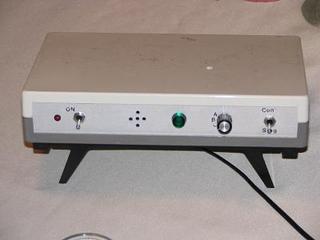PFSP-Day 7-Homework
There isn’t a whole lot to talk about today. We practiced with the Gentle Onset monitor for a while, then we were quizzed on our retention rate for the course so far. Reviewing the quiz took the rest of the morning, since every item was discussed in 1 second, stretch syllable.
By the way, all interaction in the clinic now is using targets and the 1 second, stretched syllable. I find this pretty exciting, as we are getting closer to being able to apply these skills to our daily lives.
Today, however, I would like to discuss my weekend homework though and attempt to project the enormous undertaking of this course. I glossed over this in Sunday’s post, but I failed to do it justice. I was tired and frustrated, and could have done a better job. I didn’t even discuss the Gentle Onset test box, of which I uploaded a picture.

Above is a picture of the Gentle Onset box. Pretty unassuming, I know, but it’s a frustration machine! ;-) It’s simple, with 2 items being the most important; the microphone, and the Gentle Onset indicator light. You speak into the microphone from about a foot away, and if you perform the Gentle Onset target correctly, the light comes on.
The trick to getting the light on, is to start your sound almost silently, and gradually increase your volume. If you start above a certain (unknown) volume, it won’t light. If you increase the volume too fast, it won’t light. If you don’t increase it fast enough, it won’t light. If you change your pitch, it won’t light. If you have any kind of break in your volume, it won’t light.
But just getting the light on is not enough, you need to keep it on. The light should stay on until you have achieved full volume in the practiced sound. And if you are practicing multi-sound syllables, the light should stay on, until you have stabilized the last stretchable sound.
So, if you have the word ‘SOON’; ‘S’ is not stretchable, and should be articulated as lightly as possible. ‘OO’ should be started with the Gentle Onset with an increasing volume until the light comes on. The ‘OO’ should then be slowly changed to the ‘N’ sound. If the change from the ‘OO” to the ‘N’ is too fast, or unstable, or the volume is not maintained, or your pitch changes; the light goes out.
It’s very frustrating when the light doesn’t come on. And no matter how accurate you believe your articulation is, it still doesn’t come on, or keeps going out on you. Very frustrating.
To put this in perspective, over the weekend, my homework assignment consisted of:
1.Monitor exercises for Class II sounds (stretchable consonants)
2.Covert (mental) practice for Class II sounds
3.Tape the reading of 4 paragraphs, then listen & correct
4.Have 2 conversations with somebody outside the clinic while monitoring my targets.
5.Monitor exercises for Class III sounds (air consonants; s,sh,f,etc..)
6.Covert (mental) practice for Class III sounds
7.Time my covert practice of a 50 syllable paragraph. Do this 3 times to check my timing.
Most of this isn’t that big of a deal, but 1 & 5 consisted of 273 and 180 sounds respectively. Each was performed 5 times, for a collective total of 2,265 repetitions assuming I made no mistakes. And I made plenty of mistakes.
So there you have it, this is no small undertaking by any means, and the hard part of transferring my new skills to the real world is still to come.
Not meant as advice, please find a qualified therapist if you are interested in similar therapy.


0 Comments:
Post a Comment
<< Home